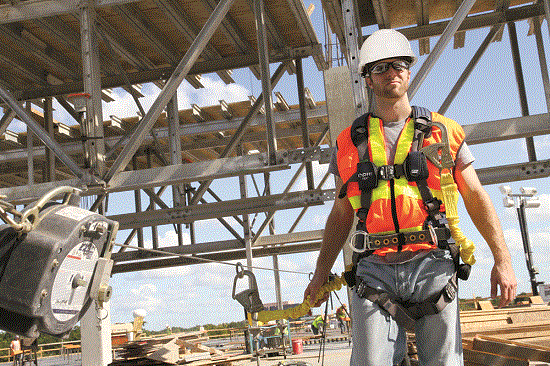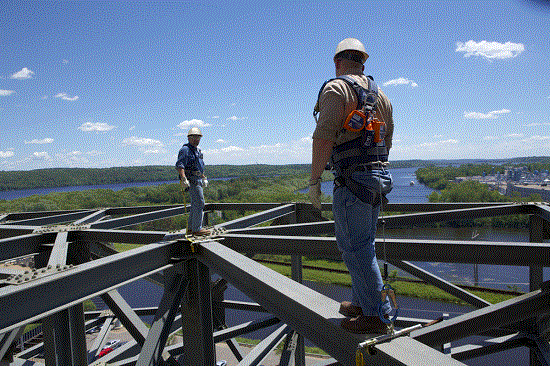Fall protection has long been a focal point for industries that have people working at height, with coatings contractors chief among them. This year, fall protection moved from an emphasis to a defined mandate.
As of January 17, 2017, a long-awaited update to the walking-working surfaces rule from the U.S. Occupational Safety and Health Administration (OSHA) became effective, establishing employer requirements for using personal fall protection systems. OSHA estimates the standard will prevent 29 fatalities and more than 5,842 injuries annually, while affecting ~112 million workers at 7 million worksites.
The final rule’s most significant update is allowing employers to select the fall protection system that works best for them, choosing from a range of accepted options, including personal fall protection systems. OSHA has permitted the use of these systems in construction since 1994, and the final rule adopts similar requirements for general industry. Other changes include allowing employers to use rope descent systems up to 300 feet (91.4 m) above a lower level; prohibiting the use of body belts as part of a personal fall arrest system; and requiring worker training on personal fall protection systems and fall equipment.
“The final rule will increase workplace protection from those hazards, especially fall hazards, which are a leading cause of worker deaths and injuries,” said David Michaels, the U.S. assistant secretary of labor for occupational safety and health when the rule was formalized earlier this year. “OSHA believes advances in technology and greater flexibility will reduce worker deaths and injuries from falls.”
In August 2014, Jim Hutter — senior trainer at Capital Safety, which became part of 3M’s fall protection division in August 2015 — wrote a well-received article at CoatingsPro Magazine on how to properly inspect fall protection equipment, including tips on the use of full body harnesses, lanyards, snap hooks and carabiners, and self-retracting lifelines. Nearly three years later, the vast majority of his advice remains astute.

The new OSHA rule, though, places additional layers into the equation. According to 3M’s fall protection experts, here’s a rundown of the areas of major legislative changes and what each means for fall protection equipment.
Fall Protection Flexibility
According to 3M, the new rule eliminates the existing mandate to use guardrails as the primary method of fall protection and grants employers the flexibility to determine what method they believe will work best in their particular workplace. The rule enables employers to use non-conventional fall protection practices in certain situations, such as designated areas on low-slope roofs for work that is temporary and infrequent, and fall protection plans on residential roofs when employers show guardrail, safety net, or personal fall protection systems are not feasible or create a greater hazard.
Fixed Ladder Requirements
Over a 20-year period, the new rule phases in a requirement to equip fixed ladders that extend over 24 feet (7.3 m) with ladder safety or personal fall arrest systems while prohibiting the use of cages and wells as a means of fall protection. In the rule, OSHA explains that cages and wells do not prevent workers from falling from fixed ladders or protect them from injury if a fall occurs. The rule grandfathers in cages and wells on existing ladders, but it requires during the phase-in period that employers equip new ladders and replacement ladders/ladder sections with ladder safety or personal fall arrest systems.
Rope Descent Systems and Certification of Anchorages
The rule prohibits employers from using Rope Descent Systems (RDS) at heights above 300 feet (91.4 m) above grade unless they demonstrate it is not feasible or creates a greater hazard to use any other system at that height, 3M explained. The rule also mandates that building owners provide and employers obtain information that permanent anchorages used with RDS have been inspected, tested, certified, and maintained as capable of supporting at least 5,000 lb. (2,268.0 kg) per employee attached.
Inspection of Walking-Working Surfaces
The rule requires employers to inspect walking-working surfaces regularly and, as needed, to correct, repair, or guard against hazardous conditions.
Personal Fall Protection System Requirements
The mandate adds requirements on the performance, inspection, use, and maintenance of personal fall protection systems. As in OSHA’s construction standards, the final rule prohibits the use of body belts as part of a fall arrest system.
Snap Hooks, D-Rings, and Carabiners
The rule requires that D-rings, snap hooks, and carabiners be proof tested to a minimum tensile load of 3,600 lb. (1,632.9 kg) without cracking, breaking, or incurring permanent deformation. OSHA also added a new requirement specifying that the gate strength of all snap hooks and carabiners must also be proof tested to 3,600 lb. (1,632.9 kg) in all directions.
Low-Slope Roofs
OSHA added the “low-slope roof” term to the final rule because, according to OSHA, although these roofs are sometimes referred to as “flat roofs,” even these roofs have some slope to allow for drainage. As such, specific fall protection requirements such as guard rails, netting, and travel restraint are specified to varying degrees, depending on how close a worker is to the edge.
Training
The rule adds requirements that employers ensure workers who use personal fall protection systems and work in hazardous situations are trained about fall and equipment hazards, including fall protection systems. These workers are to be retrained as necessary, 3M explained, and employers are called on to provide information and training to each worker in a manner in which the worker understands.
Rulings
The new updates apply to all general industry workplaces, according to 3M, with surfaces covered including floors, stairs, ladders, ramps, scaffolds, and elevated walkways. The revised standards are meant to more closely align with modern construction requirements.
The final rule on walking-working surfaces and fall protection systems was published in the U.S. Federal Register on November 18, 2016, and it can be read here in its entirety. Rules become officially effective 60 days after their Federal Register publication. While that date passed in January, there are staggered compliance deadlines that give companies time to evaluate their current equipment and safety systems while taking the needed steps to achieve compliance.
This feature is part of a special anniversary series in 2017 in which CoatingsPro reflects on and updates the magazine’s most-read digital stories. To see the original article from October 2014, please click here.
